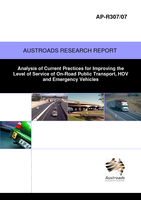Traffic Management

Analysis of Current Practices for Improving the Level of Service of On-Road Public Transport, HOV and Emergency Vehicles
- Publication no: AP-R307-07
- ISBN: 978-1-921329-27-2
- Published: 22 October 2007
- PDF (free) Download
This report describes the concept and definition of level of services (LOS) for specific road users that include on-road public transport, high occupancy vehicles (HOV) and emergency vehicles. It reviews current practices to improve their LOS and describes modelling case studies. The allocation of space to priority road users is an effective means to provide priority and improve their LOS. Examples include queue jump lanes for buses, bus/transit lanes on freeways and arterials and also bypass lanes on freeway on-ramps. The allocation of time is another effective means to provide priority, e.g. special signal phases, green extensions and phase pre-emption for buses, trams and emergency vehicles. Tools such as HOV lanes, on-road public transport schemes, etc. can be applied to increase the person throughput of a corridor. The overall success of such schemes is dependent on how successful the application is at promoting behavioural change in the community and attracting travellers to carpool or use on-road public transport as an alternative to single occupant vehicles.
- AP-R307/07 Analysis of Current Practices for Improving the Level of Service of On-Road Public Transport, HOV and Emergency Vehicles
- 1. INTRODUCTION
- 2. LEVEL OF SERVICE FOR SPECIFIC USERS
- 2.1. Level of Service for On-Road Public Transport
- 2.2. Level of Service for HOVs
- 2.3. Level of Service for Emergency Vehicles
- 3. CURRENT PRACTICES TO IMPROVE ON-ROAD PUBLIC TRANSPORT (ORPT) LEVEL OF SERVICE
- 3.1. Signal Priority for Buses and Trams
- 3.2. Bus Advance Measures
- 3.3. Bus/Tram Lanes
- 3.4. Integrated Multi-modal Operation
- 3.5. Other Methods
- 3.6. Summary
- 4. CURRENT PRACTICES TO IMPROVE HIGH-OCCUPANCY VEHICLES LEVEL OF SERVICE
- 4.1. HOV Lanes
- 4.2. AASHTO Guidelines on HOV Facilities
- 4.3. Effectiveness of HOV Lanes
- 4.4. Summary
- 5. CURRENT PRACTICES TO IMPROVE EMERGENCY VEHICLE LEVEL OF SERVICE
- 5.1. Background on Emergency Vehicle Pre-Emption System
- 5.2. Route Pre-Emption
- 5.3. Detection at a Signalised Intersection
- 5.4. GPS Tracking
- 5.5. Route Guidance
- 5.6. Summary
- 6. MODELLING OF MEASURES
- 6.1. Analytical Modelling of HOV Lane
- 6.2. Macrosimulation of an HOV Lane in a Corridor
- 6.3. Microsimulation Case Studies
- 6.4. Summary
- 7. CONCLUSIONS
- REFERENCES
Related publications
WEB-NSWMPF-22
WEB-AP-R677-22
Latest Traffic Management News
